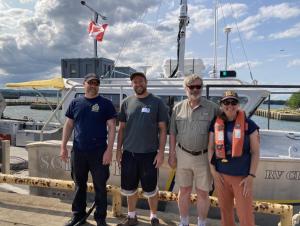

written by Lyuba Burlakova, Sasha Karatayev, and Brian Haas
On July 18th, we collected video and benthic samples from 14 stations in Hamilton Harbor (Ontario, Canada) to characterize benthic habitats and to test whether visual classification can serve as an indicator of hypoxia. This survey was made possible by our Canadian colleagues from Fisheries and Oceans Canada, scientists Kelly Bowen and Warren Currie. Captain Robert D. Linley expertly operated his newly built amazing 38-foot DFO boat R/V Cisco, equipped with large open aft deck, a small crane and A-frame, trawling winch, and a very convenient sideboard to wash benthic samples.
Hamilton Harbor has been subject to the impacts of intensive industrial and urban development around its shores for many years, and in addition to being a major shipping center, it still supports one of the largest concentrations of heavy industry in Canada. Three wastewater treatments plants and urban runoff from the cities of Hamilton and Burlington discharge into the bay. Sediments in the harbor are contaminated by metals, PCBs, and PAHs, and the bay suffers from periodic hypoxia. The harbor was designated as an Area of Concern, and its Randle Reef area is considered the largest PAH-contaminated sediment site in the Canadian Great Lakes.
This study was done within the applied research project “Study Great Lakes benthoscapes to investigate large scale changes in benthos composition and distribution affected by dreissenids and eutrophication” in our EPA-funded project “Great Lakes Long-term Biological Monitoring.” Communities of benthic macroinvertebrates are among the most useful indicators for biological assessment of environmental and anthropogenic stressors, but both sample processing and species identification often require several years to complete. Mapping benthic landscapes or “benthoscapes” using underwater video can provide valuable and cost-effective assessment of bottom habitats on large spatial scales with minimal habitat disturbance. In 2019, during the CSMI benthic survey in Lake Erie, we successfully used this approach to characterize benthic habitats and confirmed that video analysis can provide a quick and reliable method to detect habitats affected by periodic hypoxia. Last year, in collaboration with Paris Collingsworth (Illinois-Indiana Sea Grant), his M.S. student Justin Meyer, and Cornell University M.S./Ph.D. graduate student Sarah Lawhun, we sampled Saginaw Bay of Lake Huron at stations where oxygen loggers were deployed to detect near-bottom hypoxia. We are very thankful to K. Bowen, R. D. Linley, W. Currie, P. Collingsworth, and J. Meyer for facilitating our surveys.
The samples from the Hamilton Harbor have been already sorted, and taxa identification and video analysis will be done over winter and spring. By testing this method on several locations in the Great Lakes that suffer from periodic hypoxia, we can determine if video analysis can be used as a quick and reliable method to detect hypoxic habitats. Such rapid methods may be important for regional monitoring of over 20 hypoxic zones documented in the Great Lakes where the extent and magnitude of hypoxia currently represent a major knowledge gap.
Image caption: Captain Robert Linley, Brian Haas, Sasha Karatayev, and Kelly Bowen after a successful survey.
Some content on this page is saved in PDF format. To view these files, download Adobe Acrobat Reader free. If you are having trouble reading a document, request an accessible copy of the PDF or Word Document.
